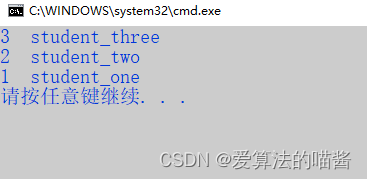目录
map是STL的一个关联容器,它提供一对一(其中第一个可以称为关键字,每个关键字只能在map中出现一次,第二个可能称为该关键字的值)的数据 处理能力,由于这个特性,它完成有可能在我们处理一对一数据的时候,在编程上提供快速通道。这里说下map内部数据的组织,map内部自建一颗红黑树(一 种非严格意义上的平衡二叉树),这颗树具有对数据自动排序的功能,所以在map内部所有的数据都是有序的,后边我们会见识到有序的好处。
1、map介绍
map是一类关联式容器。它的特点是增加和删除节点对迭代器的影响很小,除了操作的节点,对其他的节点都没有什么影响。
对于迭代器来说,可以修改实值,而不能修改key。
2、map的功能
自动建立Key - value的对应。key 和 value可以是任意你需要的类型。
根据key值快速查找记录,查找的复杂度基本是Log(N),如果有1000个记录,最多查找10次,1,000,000个记录,最多查找20次。
快速插入Key -Value 记录。
快速删除记录
根据Key 修改value记录。
遍历所有记录。
3、map的使用
使用map得包含map类所在的头文件
#include <map> //注意,STL头文件没有扩展名.h
map对象是模板类,需要关键字和存储对象两个模板参数:
map<int,string> personnel;
这样就定义了一个用int作为索引,并拥有相关联的指向string的指针.
为了使用方便,可以对模板类进行一下类型定义,
typedef map<int,CString> UDT_MAP_INT_CSTRING;
UDT_MAP_INT_CSTRING enumMap;
4 、map的创建
#include<iostream>
#include<map>
using namespace std;
int main()
{
map<int, string> mapStudent;
return 0;
}
5、数据的插入
map容器常用的数据插入有两种:
第一种:用insert函数插入pair数据
//数据的插入--第一种:用insert函数插入pair数据
#include <map>
#include <string>
#include <iostream>
using namespace std;
int main()
{
map<int, string> mapStudent;
mapStudent.insert(pair<int, string>(1, "student_one"));
mapStudent.insert(pair<int, string>(2, "student_two"));
mapStudent.insert(pair<int, string>(3, "student_three"));
//遍历输出map成员
map<int, string>::iterator iter;
for(iter = mapStudent.begin(); iter != mapStudent.end(); iter++)
cout<<iter->first<<' '<<iter->second<<endl;
} 第二种:用数组方式插入数据,下面举例说明
//第三种:用数组方式插入数据,下面举例说明
#include <map>
#include <string>
#include <iostream>
using namespace std;
int main()
{
map<int, string> mapStudent;
mapStudent[1] = "student_one";
mapStudent[2] = "student_two";
mapStudent[3] = "student_three";
map<int, string>::iterator iter;
//遍历输出map成员
for(iter = mapStudent.begin(); iter != mapStudent.end(); iter++)
cout<<iter->first<<' '<<iter->second<<endl;
} 以上用法,虽然都可以实现数据的插入,但是它们是有区别的,用insert函数插入数据,在数据的 插入上涉及到集合的唯一性这个概念,即当map中有这个关键字时,insert操作是插入数据不了的,但是用数组方式就不同了,它可以覆盖以前该关键字对 应的值,用程序说明
mapStudent.insert(map<int, string>::value_type (1, "student_one"));
mapStudent.insert(map<int, string>::value_type (1, "student_two")); //该语句失效,插入失败
mapStudent[1] = "student_one";
mapStudent[1] = "student_two"; //"student_two"会覆盖"student_one"判断insert语句是否插入成功
pair<map<int, string>::iterator, bool> Insert_Pair;
Insert_Pair = mapStudent.insert(map<int, string> (1, "student_one"));我们通过pair的第二个变量来知道是否插入成功,它的第一个变量返回的是一个map的迭代器,如果插入成功的话Insert_Pair.second应该是true的,否则为false。
以下代码演示检验是否insert语句插入成功
//验证插入函数的作用效果
#include <map>
#include <string>
#include <iostream>
using namespace std;
int main()
{
map<int, string> mapStudent;
pair<map<int, string>::iterator, bool> Insert_Pair;
Insert_Pair = mapStudent.insert(pair<int, string>(1, "student_one"));
if(Insert_Pair.second == true)
cout<<"Insert Successfully"<<endl;
else
cout<<"Insert Failure"<<endl;
//运行结果:插入成功,输出"Insert Successfully"
Insert_Pair = mapStudent.insert(pair<int, string>(1, "student_two"));
if(Insert_Pair.second == true)
cout<<"Insert Successfully"<<endl;
else
cout<<"Insert Failure"<<endl;
//运行结果:插入失败,输出"Insert Failure"
return 0;
}
6、 map的大小
在往map里面插入了数据,我们怎么知道当前已经插入了多少数据呢,可以用size函数,用法如下:
Int nSize = mapStudent.size();7、 数据的遍历
这里也提供三种方法,对map进行遍历
第一种:应用前向迭代器,上面举例程序中到处都是了,就不举例了
第二种:应用反相迭代器,下面举例说明
//第二种,利用反向迭代器
#include <map>
#include <string>
#include <iostream>
using namespace std;
int main()
{
map<int, string> mapStudent;
mapStudent.insert(pair<int, string>(1, "student_one"));
mapStudent.insert(pair<int, string>(2, "student_two"));
mapStudent.insert(pair<int, string>(3, "student_three"));
map<int, string>::reverse_iterator iter;
for(iter = mapStudent.rbegin(); iter != mapStudent.rend(); iter++)
{
cout<<iter->first<<" "<<iter->second<<endl;
}
return 0;
} 运行结果:

8、map中查找元素
在这里我们将体会,map在数据插入时保证有序的好处。
要判定一个数据(关键字)是否在map中出现的方法比较多,这这里给出2种数据查找方法
第一种:用count函数来判定关键字是否出现,其缺点是无法定位数据出现位置,由于map的特性,一对一的映射关系,就决定了count函数的返回值只有两个,要么是0,要么是1,出现的情况,当然是返回1了
第二种:用find函数来定位数据出现位置,它返回的一个迭代器,当数据出现时,它返回数据所在位置的迭代器,如果map中没有要查找的数据,它返回的迭代器等于end函数返回的迭代器。
查找map中是否包含某个关键字条目用find()方法,传入的参数是要查找的key,在这里需要提到的是begin()和end()两个成员,分别代表map对象中第一个条目和最后一个条目,这两个数据的类型是iterator.
程序说明
#include <map>
#include <string>
#include <iostream>
using namespace std;
int main()
{
map<int, string> mapStudent;
mapStudent.insert(pair<int, string>(1, "student_one"));
mapStudent.insert(pair<int, string>(2, "student_two"));
mapStudent.insert(pair<int, string>(3, "student_three"));
map<int, string>::iterator iter;
iter = mapStudent.find(1);
if(iter != mapStudent.end())
cout<<"Find, the value is "<<iter->second<<endl;
else
cout<<"Do not Find"<<endl;
return 0;
} 9、 从map中删除元素
移除某个map中某个条目用erase()
该成员方法的定义如下:
iterator erase(iterator it);//通过一个条目对象删除
iterator erase(iterator first,iterator last)//删除一个范围
size_type erase(const Key&key);//通过关键字删除
clear()就相当于enumMap.erase(enumMap.begin(),enumMap.end());
这里要用到erase函数,它有三个重载了的函数,下面在例子中详细说明它们的用法
#include<map>
#include <iostream>
#include<string>
using namespace std;
int main()
{
map<int, string> mapStudent;
mapStudent.insert(pair<int, string>(1, "student_one"));
mapStudent.insert(pair<int, string>(2, "student_two"));
mapStudent.insert(pair<int, string>(3, "student_three"));
//如果要删除1,用迭代器删除
map<int, string>::iterator iter;
iter = mapStudent.find(1);
mapStudent.erase(iter);
//如果要删除1,用关键字删除
int n = mapStudent.erase(1);//如果删除了会返回1,否则返回0
//用迭代器,成片的删除
mapStudent.erase(mapStdent.begin(),mapStudent.end());
//一下把整个map清空
mapStudent.erase( mapStudent.begin(), mapStudent.end() );
mapStudent.clear();
//成片删除要注意的是,也是STL的特性,删除区间是一个前闭后开的集合
return 0;
} 10、 排序 · map中的sort问题
map中的元素是自动按Key升序排序,所以不能对map用sort函数;
这里要讲的是一点比较高深的用法了,排序问题,STL中默认是采用小于号来排序的,以上代码在排序上是不存在任何问题的,因为上面的关键字是int 型,它本身支持小于号运算,在一些特殊情况,比如关键字是一个结构体,涉及到排序就会出现问题,因为它没有小于号操作,insert等函数在编译的时候过 不去,下面给出两个方法解决这个问题。
小于号重载,程序举例。
#include <iostream>
#include <string>
#include <map>
using namespace std;
typedef struct tagStudentinfo
{
int niD;
string strName;
//重载小于小于号
bool operator < (tagStudentinfo const& _A) const
{ //这个函数指定排序策略,按niD排序,如果niD相等的话,按strName排序
if(niD < _A.niD) return true;
if(niD == _A.niD)
return strName.compare(_A.strName) < 0;
return false;
}
}Studentinfo, *PStudentinfo; //学生信息
int main()
{
int nSize; //用学生信息映射分数
map<Studentinfo, int>mapStudent;
map<Studentinfo, int>::iterator iter;
Studentinfo studentinfo;
studentinfo.niD = 1;
studentinfo.strName = "student_one";
mapStudent.insert(pair<Studentinfo, int>(studentinfo, 90));
studentinfo.niD = 2;
studentinfo.strName = "student_two";
mapStudent.insert(pair<Studentinfo, int>(studentinfo, 80));
for (iter=mapStudent.begin(); iter!=mapStudent.end(); iter++)
cout<<iter->first.niD<<' '<<iter->first.strName<<' '<<iter->second<<endl;
return 0;
}
还要说明的是,map中由于它内部有序,由红黑树保证,因此很多函数执行的时间复杂度都是log2N的,如果用map函数可以实现的功能,而STL Algorithm也可以完成该功能,建议用map自带函数,效率高一些。
12、 map的基本操作函数
C++ maps是一种关联式容器,包含“关键字/值”对
begin() 返回指向map头部的迭代器
clear() 删除所有元素
count() 返回指定元素出现的次数
empty() 如果map为空则返回true
end() 返回指向map末尾的迭代器
equal_range() 返回特殊条目的迭代器对
erase() 删除一个元素
find() 查找一个元素
get_allocator() 返回map的配置器
insert() 插入元素
key_comp() 返回比较元素key的函数
lower_bound() 返回键值>=给定元素的第一个位置
max_size() 返回可以容纳的最大元素个数
rbegin() 返回一个指向map尾部的逆向迭代器
rend() 返回一个指向map头部的逆向迭代器
size() 返回map中元素的个数
swap() 交换两个map
upper_bound() 返回键值>给定元素的第一个位置
value_comp() 返回比较元素value的函数




















 741
741











 被折叠的 条评论
为什么被折叠?
被折叠的 条评论
为什么被折叠?








